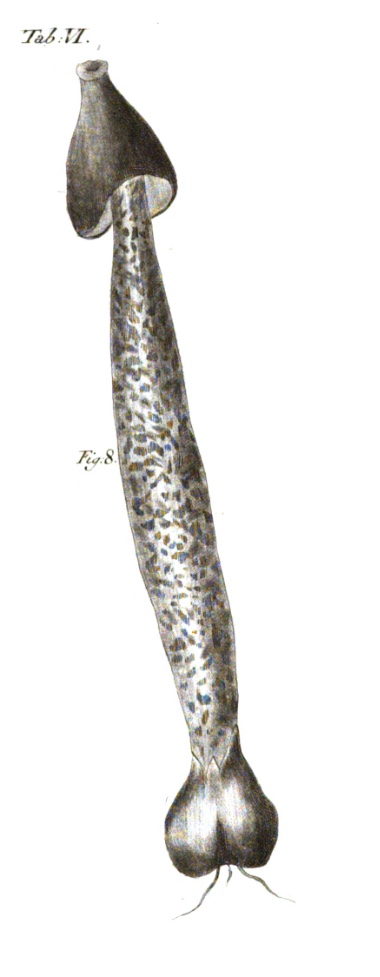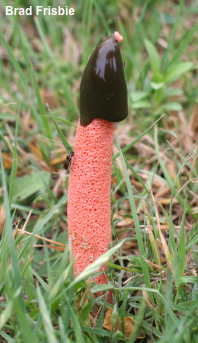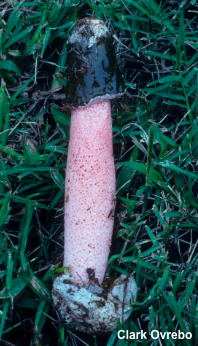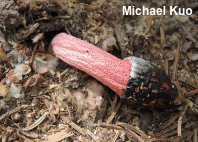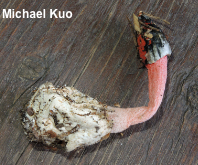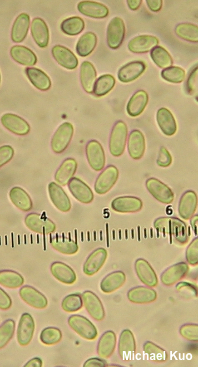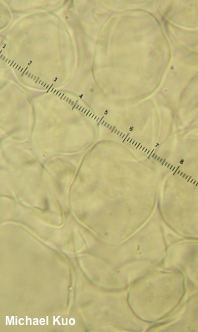| Major Groups > Stinkhorns > Phallus rubicundus |

|
Phallus rubicundus [ Basidiomycota > Agaricomycetes > Phallales > Phallaceae > Phallus . . . ] by Michael Kuo Originally described from South Carolina, Phallus rubicundus is a red- to pink-stemmed stinkhorn with a clearly separated, conical head. Its distribution includes the southeastern United States, as well as Texas, Oklahoma, and Colorado. Outside of North America it is found in Africa and Asia. However, a precise accounting of the range of Phallus rubicundus is difficult, because it has been confused with Phallus rugulosus by many authors (including me). The latter species has an orange-when-fresh stem and is generally a bit more slender. Both species, along with Phallus aurantiacus, have dull orange stems as dried, which might help to explain some of the taxonomic confusion regarding these species over the years, since Phallus rubicundus loses its pink to red shades in the herbarium; mycologists studying dried specimens would be hard-pressed to discover morphological differences. Many treatments, including Calonge (2005) and Kuo & Methven (2010, 2014), have combined Phallus rubicundus with Phallus rugulosus. Brazilian treatments of Phallus rubicundus (e.g. Cortez and Silva-Filho 2017, Medeiros et al. 2017, Trierveiler-Pereira et al. 2009) appear to represent Phallus rugulosus, as does the treatment of Phallus rubicundus in Hawaii by Hemmes and Desjardin (2002). Thanks to Brad Frisbie for documenting, collecting, and preserving Phallus rubicundus for study; his collection is deposited in The Herbarium of Michael Kuo. Thanks to Clark Ovrebo for facilitating study of the collections cited below. Thanks to Stephen Canfield for his translation (see below) of the original Phallus aurantiacus description. Description: Ecology: Saprobic; growing alone or gregariously in urban locations, including lawns and cultivated areas, as well as woodchip beds; spring through fall in temperate climates, but potentially year round in tropical and subtropical areas; originally described from South Carolina; distributed in North America from the southeastern states to Texas and Oklahoma (where it is very common), and in Colorado; also recorded from Africa and Asia. The illustrated and described collections are from Colorado and Oklahoma. Immature Fruiting Body: Like a whitish "egg"; when sliced revealing the stinkhorn-to-be encased in a gelatinous substance. Mature Fruiting Body: Cylindric, with a clearly differentiated head structure that is separate from the stem but may collapse against the stem surface with age. Head: 2–3.5 cm high; attached to the top of the stem; conic or nearly so; often becoming perforated at the apex; smooth or finely wrinkled; red to pink, with a whitish lower margin; initially covered by dark brown to nearly black spore slime; sometimes with a few patches of universal veil. Stem: 8–13 cm high; 1.5–2 cm thick; cylindric or somewhat swollen in the middle or below; dry; pinkish red to pink when fresh, fading to pale orange; pocketed; hollow; base enclosed in a white, brown-stained volva 1–2 cm high; attached to white rhizomorphs. Microscopic Features: Spores 4–5 x 2–2.5 µm; ellipsoid; smooth; hyaline in KOH. Sphaerocysts of the pseudostipe 18–67 µm; irregularly subglobose; smooth; walls 0.5–1 µm thick; hyaline in KOH. Hyphae of the volva 2–5 µm wide; smooth; hyaline in KOH; occasionally clamped at septa. REFERENCES: (Bosc, 1811) Fries, 1823. (Long, 1907; Coker & Couch, 1928; Dring & Rayner, 1967; Dring & Rose, 1977; Hosaka, 2010; Hosaka, 2012.) Herb. Kuo 05071201, 08101501. Herb. CSU CLO 3220, CLO 4186, CLO 4473. Satyrus rubicundus Bosc, Magazin der Gesellschaft Naturforschenden Freunde Berlin 5: 86 (1811). English translation of protologue by Stephen Canfield RUBICUND SATYR. Satyrus rubicundus Bosc. Satyr featuring a spongy, red, fusiform stipe with a small gray volva at its base; the cap is conical, glabrous, dark brown in color, with a small oval hole at the tip. This species appears in autumn and is found only in the driest terrain of South Carolina. It gives off an extremely unpleasant odor. The volva contains a gelatinous substance; the stipe is perforated with a large number of holes of unequal size and irregular distribution. The cap is covered with a viscous substance that gradually decays with maturity or within a few hours of being picked. Plate 6. Fig. 8 is a life-sized representation of a rubicund satyr. Banister and Rey have represented mushrooms that have common elements with the preceding two [Phallus duplicatus and Satyrus rubicundus].
(Protologue illustration, public domain, adapted from a scan provided online by the Hathi Trust Digital Library (https://babel.hathitrust.org/cgi/pt?id=hvd.32044106317993). This site contains no information about the edibility or toxicity of mushrooms. |
© MushroomExpert.Com |
|
Cite this page as: Kuo, M. (2019, December). Phallus rubicundus. Retrieved from the MushroomExpert.Com Web site: http://www.mushroomexpert.com/phallus_rubicundus.html |
